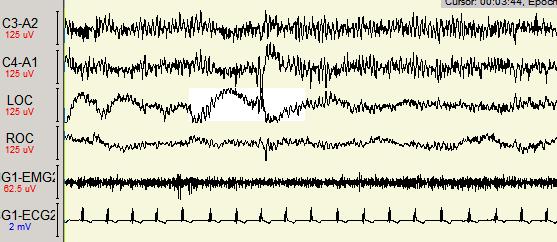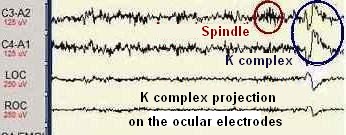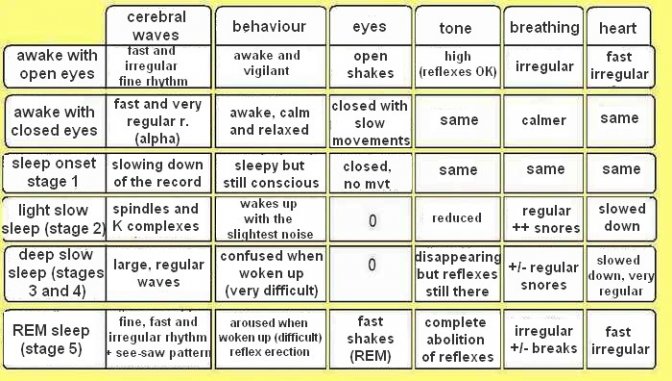Home > Welcome > Sleep-wake pathologies > Know how to sleep > Iconography of the characteristics of sleep
Iconography of the characteristics of sleep
Friday 12 October 2007
All the versions of this article: [English] [français]
General map of the « iconography » section:
- « Assembly» for polysomnography;
- Sleep characteristics:(you are here);
- A chart which summarizes the sleep characteristics;
- Graph-elements of the different stages of sleep;
- Awake with open eyes;
- Awake with closed eyes;
- Sleep onset, stage 1;
- Slow light sleep, stage 2;
- Slow deep sleep, stages 3 and 4;
- REM sleep;
- Normal and pathological hypnograms;
- Respiratory events during sleep;
- Periodic limb movements;
- Spectral analysis and final report.

- Hypnogramme normal
Polysomnographic definitions of the sleep stages according to the «Rechtschaffen and Kales manual » ("Rechtschaffen and A. Kales, A Manual of Standardized Terminology, Techniques, and Scoring System for Sleep Stages of Human Subjects"; 1968).
Summarizing chart of the sleep characteristics.
The graph-elements of the different sleep stages.
- "C3A2" et "C4A1" are the two lines obtained from the difference of electric potential measured at the surface of the skull. That electric activity takes the shape of sinusoid waves of which the amplitude (in microvolt) and the frequency (number of cycles in one second) determine the different levels of arousal. [1]
- "LOC" et "ROC" are the lines of the electric activity produced by the muscles in charge of the movements of the right ("ROC" = right oculogram) and left ("LOC"= left oculogram) eyes. Slow movements (NREM) or rapid movements (REM) can be distinguished. The captors are set in a way that the phase or counter phase movements of both eyes can be distinguished. [2]
- The EMG (electromyogram) witnesses for the electric activity produced by a little muscle on the chin. At rest or during slow wave sleep, that muscle keeps a basic tone which completely disappears during REM sleep. (In practice, that matches the shape of the sheets printed on the face’s skin or to some sensations of sleep paralysis.)
- The ECG (electrocardiogram) is the record of the more or less rapid or irregular activity of the heart depending on the sleep stages.
- Awake with open eyes
The EEG shows a rhythm called "beta" made of irregular and low voltage fast frequencies (higher than 14 cycles/second [3] ).
The eye movements are fast (reading activity?), muscle tone is intense, matching deliberate movements (speech ?).
- Wake state (EEG and EMG)
- Awake with closed eyes
That very regular rhythm of 8 to 13 c/s is called "Alpha". It witnesses for a calm and relaxed mental state with closed eyes and it is interrupted as soon as the eyes open, thereby activating the visual areas of the brain.

- Awake with closed eyes : alpha rhythm and slow eye movements
- Sleep onset, Stage 1:
The EEG activity is slower (3 to 7 c/s) and of low voltage, described as "Theta", with slow eye movements, in phase, and a stop of the body movements.

- Slow Light Sleep, Stage 2:
Theta EEG activity showing the two graph elements which are characteristic of that stage :
- the spindles, small outbursts of fast rhythm of 15 to 18 c/s of which the amplitude increases and decrease.
- K complexes, big biphasic waves which often artefact the EOG while there are no eye movements (non REM sleep). [4]

- Slow Deep Sleep :
Stage 3 : presence of large slow "Delta" waves (0,5 à 2,5 c/s) on at least 30% of the page.
Stage 4 (sup. 50%);
Muscle tone is low and sometimes disappears completely.
The heart is regular and slightly slowed down, blood pressure is stable (lower than during wake), body temperature is also stable.

- REM Sleep :

Fast low voltage activity (similar to arousal), with, sometimes, some outbursts of “see-saw” looking rhythmic waves, specific to that stage.
REM Sleep is characterized by the presence of fast shakes of the oculomotor muscle (REM stands for Rapid Eye Movement) which persist despite the complete abolition of muscle tone, which is recorded on the chin.

Blood pressure becomes remarkably more and more irregular, so does the breathing frequency, and also the cardiac rhythm (the only systems of muscles which are not totally paralysed during REM sleep).
The total absence of thermal regulation is also to be noted. The absence of thermoregulation during REM sleep explains some nocturnal sweats and the danger of sleeping in snow or, for example, during the last heat wave, in elder people who are often made more vulnerable by the abuse of sleeping pills.
All these physiological disturbances witness for the provisory suspension of nearly all the regulation functions of the organism during REM sleep, which strangely contrasts with the intensity of the EEG activity (that is why Pr. M. Jouvet chose the term "paradoxical" in French in Lyon in 1961).The flat EMG of REM sleep shows tiny discharges called "twitches" which match the small shakes of the face or of the fingers (of the whiskers or paws in dogs and cats) which can be observed during sleep and which we link to the oniric activity (the content of the dream?).

- REM sleep with atonia and twitches
Note.
A congestion of the sexual organs (erection) is present at that stage in all mammals. Its meaning remains a mystery but it is sometimes recorded in sexology to make out the organic impotencies from the functional ones.
See next article: Normal and pathological hypnograms.
Personal iconography Dr Guilhem Pérémarty.
Free of copyright (Copyleft) ... provided the source is mentioned.
[1] These electric "micro-discharges", which are recorded on the electroencephalogram, are wide and regular when the neurons are at rest and thin and desynchronized when each neuron "works" on its own like during wake or REM sleep (therefore called paradoxical sleep in French).
[2] The Rapid Eyes Movements are characteristic of what French people call paradoxical sleep, opposed to slow wave sleep.
The slow eye movements are typical of sleep onset.
The eye movements are fast during wake state and they are phase synchronized (on the same side), to the opposite of the fast eye movements of REM sleep which are phase opposed.
[3] 1 Hz - Hertz is one cycle/second
[4] (The spindles are interpreted like signs of a good quality of sleep, while K complexes appear like a sign of "protection" of sleep, produced when there is a noise, for example)
